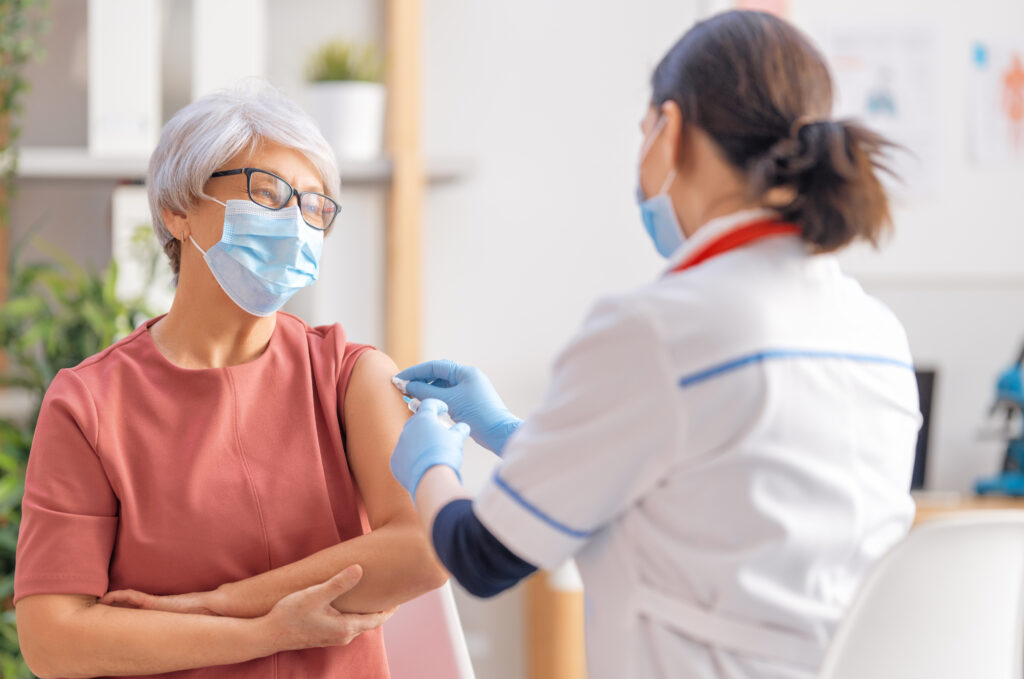The traditional role of a practicing physician is rightfully patient-focused. They skillfully handle each case that enters their office, diagnosing and treating the patients and families under their care. However, in addition to this vital role of providing care for patients, physicians are often called on to identify and diagnose public health crises affecting not just the patients in their offices, but entire communities.
One must not look too far afield to find a fitting example.
Flint’s switch to sourcing its municipal water to the Flint River and all the problems that came with it began to sound the alarm bells for Flint pediatrician Mona Hanna-Attisha. In the summer of 2015, a friend who was a water expert informed her that Flint’s water was likely contaminated with lead. Doctor Hanna-Attisha quickly connected the dots on what this could mean for the patients under her care and all community residents: exposure to lead could cause enduring cognitive and behavioral issues, particularly in children.
Immediately, Doctor Hanna-Attisha sprang into action, designing a study to conclusively answer the question no one else had thought to ask: was Flint’s water poisoning its children?
The results were unassailable. A press conference was scheduled.
According to her work, the percentage of children in Flint with lead poisoning had doubled since the city had switched the source of its water supply. The day Doctor Hanna-Attisha shared her findings with the world certainly was not the naissance of this particular public health disaster, but it was the day the Flint water crisis was officially born.
Of course, there is far more to the account leading up to that day, and nearly a decade later, the story’s final chapters are still unfolding. The important takeaway as it pertains to this piece is that the Flint water crisis demonstrated the enormous impact physicians can have in supporting public health.
Doctor Hanna-Attisha acted as an advocate, not just for her patients but for her whole community. Her actions and the coordinated response from physicians and public health officials working together to provide lead testing, health education, and resources to Flint’s residents undoubtedly made a difference in mitigating the ill effects of a massive public health disaster.
The actions of Doctor Hanna-Attisha are an excellent example for all Michigan physicians. Physicians are uniquely equipped to come alongside our local public health departments when all hands are needed on deck in times of crisis. Battling against falling vaccination rates and the growing threat of infectious disease outbreaks, the rising prevalence of chronic diseases, the ongoing opioid and drug misuse epidemic, and mitigating the growing environmental threats often revealed and sometimes compounded by Michigan’s aging infrastructure is an enormous undertaking. Solving and managing such a wide breadth of challenges would be a tall order for even the most well-funded, well-staffed, and well-supported system of organizations and agencies. However, amid these problems, local health departments struggle against budget constraints, staffing shortages, and issues with public mistrust—problems that were further exacerbated by another public health crisis, the prolonged COVID-19 pandemic.
In short, the deck is stacked against public health in Michigan.
The good news is that Michigan’s physician community can—and is—making a real and lasting difference in helping to address these challenges. But just like any other effort to understand and successfully tackle a problem, the first step is relatively passive.
It starts with education.
To be effective in supporting and enhancing public health in Michigan, physicians must first understand the current state of the system and appreciate the challenges it is facing. This article will provide that context and offer some guidance for physicians interested in taking steps to support a more robust, more resilient public health system in this state.

The Structure of Public Health in Michigan
By nature, public health is complex. To some extent, it is both science and art and extremely broad in its scope and structure. Simply put, public health is a system and infrastructure designed to protect people from unsafe conditions, prevent disease, and promote the health and well-being of individuals and the community.
Naturally, there are several players and partners in that system, including lawmakers, community organizations, businesses, colleges, universities and schools, community health centers, and the state and local health departments serving as its foundation.
In that arena, Michigan is served by the Michigan Department of Health and Human Services (MDHHS), as well as a network of 45 local health departments of varying size and structure: 30 are county health departments, 14 are multi-county jurisdictions ranging from anywhere between two and ten counties in coverage, with Detroit being the lone city health department.
“Just taking the time to understand where you fit in this landscape and who and what resources are at your disposal in terms of public health is a huge first step every Michigan physician needs to take,” said Doctor Jennifer Morse, Medical Director of the Central Michigan District Health Department, Mid-Michigan District Health Department, and District Health Department #10—a coverage area spanning a total of 19 counties in central and northern Michigan—and Assistant Professor of Family Medicine at Michigan State University College of Human Medicine and Medical Director. “When I talk with medical students, one of the first things I encourage them to do when they’re starting someplace is to find out where their local health department is, who their medical director is, and how best to get ahold of that person should they ever have questions. It doesn’t sound like much, but equipping physicians with that information and empowering them to call upon it when appropriate is a critical and overlooked key to strengthening the partnership between physicians and public health officials.”
Given the vast set of services and responsibilities under the purview of local health departments, having that information, and calling upon it when appropriate should pay dividends for healthcare practitioners and patients alike. While Michigan’s public health system is a decentralized one, with local public health departments functioning independently of the state, one can reasonably anticipate a great deal of commonality between departments in terms of their function and offerings, including:
- Disease Control: Michigan’s local health departments are responsible for monitoring, investigating, preventing, and controlling infectious and communicable diseases. This includes running vaccination programs and responding to disease outbreaks.
- Environmental Health: This involves inspecting and regulating various environmental and community health hazards, such as food safety in restaurants, public swimming pools, drinking water, sewage disposal systems, and hazardous waste.
- Maternal and Child Health Services: These services can include prenatal care, family planning, parenting education, and infant and child health programs.
- Health Education: Michigan’s local health departments are expected to provide education and information to help people make healthy choices. This can cover various topics, from nutrition and exercise to tobacco use and injury prevention.
- Health Promotion: Activities are geared towards promoting health and preventing disease within the community.
- Emergency Preparedness: Michigan’s local health departments have a role in preparing for and responding to public health emergencies, such as disease outbreaks, natural disasters, and bioterrorism events.
- Administration and Enforcement of Health Laws: Michigan’s local health departments enforce state and local public health laws and regulations.
Michigan’s public health code also mandates several services local public health departments are responsible for providing. These services are 1) immunizations, 2) sexually transmitted disease control, 3) infectious disease control, 4) hearing screening, 5) vision screening, 6) food safety inspection, 7) drinking water protection, and 8) on-site sewage management.
“A tremendous set of responsibilities fall under the umbrella of our local public health departments—certainly far more than I realized when I was a practicing physician,” said Doctor Morse. “Whether it be tracking and containing an infectious disease outbreak or more broadly working to address the socioeconomic factors that contribute to one’s health, I can almost guarantee that your public health department is doing its very best to assess and address the most pressing health needs of the community it serves.”

The Challenges Facing Public Health in Michigan
Given the enormous breadth of responsibilities falling on the shoulders of public health, it should be no surprise that a lack of adequate funding tops the list of the most significant challenges facing Michigan’s local public health departments, according to Norm Hess, executive director for the Michigan Association for Local Public Health.
“It is a chronic issue that goes back decades,” said Hess. “The cost associated with the eight basic services Michigan’s local health departments are mandated to provide should be shared equally between the state and local governments. However, the state has not met its end of the obligation since 1993. That puts a tremendous amount of strain on these departments.”
As a result, local public health departments often need help to amass the funding necessary to operate, sometimes shuffling money and resources away from other areas of need.
“Cobbling together these budgets has been a juggling act for these departments over the years, and they deserve much credit for making do with the limited funding they have had to work with,” said Hess. “But I think the COVID-19 pandemic made it abundantly clear to everyone that no one wants a public health infrastructure that is hamstrung by a lack of resources.”
The pandemic exposed and likely exacerbated many of the cracks in a public health infrastructure that has been starving for investment, chief among them being issues with workforce recruitment and retention.
“Over the past three years, we’ve lost 18 of our 42 health officers—that’s over a third of our most important leaders in public health here in Michigan,” said Hess. “Not to mention the loss of countless other staff like nurses and sanitarians. And it makes sense that we’re seeing this kind of attrition when you consider these clinicians and other professionals can often make a lot more money in the private sector, not to mention the enormous amount of stress and pressure that comes along with being on the frontlines of managing a global pandemic.”
Compounding that stress was the vitriol public health departments and officials were forced to contend with during the height of the pandemic. With both the general public and elected officials widely divided on the appropriate course of action regarding COVID-19 prevention and containment, seemingly every decision made by local health departments in response to the pandemic was met with scorn from some groups.
“For three years, these people were in the unenviable position of needing to make decisions when there were no universally good paths to follow,” said Hess. “And while they always went with the route where they felt like they were going to have the best chance of keeping people out of the hospital and ultimately saving lives, those choices often came at the cost of people not being able to operate their businesses like they once had, or visit their loved ones in the nursing home, or participate in their final season of high school basketball. Needless to say, the pandemic really strained public health’s relations with the public and many of its community partners, and many of those feelings of ill will still linger today.”

The Role of Physicians in Strengthening Public Health
The good news is that a physician can do a lot to support and strengthen Michigan’s public health system. By leveraging their knowledge, skills, and position within the community, physicians have the potential to make significant contributions to public health efforts and initiatives. Here are several ways that physicians can make a difference:
1. More communication, more collaboration.
Given all the complexities and challenges facing public health, the most impactful action physicians can take is a relatively simple one, according to Doctor Morse. It starts with better communication.
“I know when I was in practice, I didn’t know what the health department did, and that’s because I didn’t communicate with them as I should have. I didn’t appreciate all they could have done for me because the communication wasn’t there,” said Doctor Morse. “But now that I’m on the other side, I appreciate how challenging that is from the public health side of things, especially in rural areas like the one I cover where medical directors are just stretched so thin. So, I think the most impactful thing physicians can do to support public health is to reach out to their medical directors to establish that relationship. Confirm that you’re doing everything you should be doing to support public health, but then find out how your local department can better support you.”
One area where more robust communication and collaboration between physicians and public health could pay dividends is vaccinations.
“Unfortunately, fewer and fewer physicians have vaccines in-house these days, and I completely understand why that’s the case given all the storage and documentation challenges that come along with that,” said Doctor Morse. “However, if there are physicians out there who are interested in being able to administer vaccines on-site, let us know because we all have nurses dedicated to helping providers do exactly that. And having physicians be able to say, ‘and we can give you that vaccine today’ at the end of their wellness check instead of asking a patient or parent to take the extra step of going somewhere else for their vaccinations would be a huge benefit to public health, so we’re here to do everything in our power to help you do that successfully.”
2. Educate and inform your patients.
Physicians can also tremendously impact public health just through their interactions with their patients.
“People trust their doctors, so it makes a tremendous impact when physicians reinforce important messages around immunizations, disease prevention, and effectively managing chronic conditions,” said Hess. “A little bit of education can go a long way in helping people live longer, healthier lives.”
Even the apparent work of promoting preventative care and encouraging patients to adopt better behaviors, like healthy eating, increased physical activity, and pursuing regular check-ups, can make a difference in preventing the development of chronic conditions at the population level.
Hess was also quick to add that vocal support from Michigan’s physician community would be particularly beneficial now, given the challenges public health has faced over the past few years. By simply providing accurate information and addressing misconceptions, physicians can play a critical role in rebuilding trust in local public health departments and supporting and improving the general health and well-being of the communities they serve.
“Having people who are not necessarily in public health but who are supportive of the public health system who can help to dispel misinformation and reaffirm sound information regarding public health strategies would be extremely beneficial in today’s climate,” said Hess.” And there is no one better suited to fill that role than a physician. Their voice is critical in our ongoing efforts to reestablish broader trust in our public health system.”
3. Be an advocate for public health and health equity.
While the COVID-19 pandemic helped to expose and widen many of the cracks and flaws in the United States healthcare system, a more optimistic read of this experience is that it demonstrated exactly where more investment should be focused.
“I think we’re all starting to come to grips with just how impactful the social determinants of health are on both people’s health and wellbeing,” said Doctor Morse. “We certainly saw undeniable evidence of that during the COVID-19 pandemic, with people of color bearing a disproportionate burden of both cases and deaths. And I see it every day in my region, where these fundamental issues like poverty, lack of education, and lack of transportation all play an enormous role in creating and exacerbating health issues.”
Physicians have a unique opportunity to catalyze solutions for these issues, as they are often the first point of contact for patients within the health care system. It starts with screening for social determinants of health and patient education, but there’s also a role for advocacy.
“There’s no question that organized medicine’s voice is a powerful one, and using it to explicitly advocate for more funding and support for public health infrastructure would be great,” said Doctor Morse. “But I think it also needs to be said that there are plenty less direct interventions physicians can support that would also greatly benefit the health and wellbeing of entire communities. Advocating for better access to health care and mental health services, promoting health equity, pushing for policies that reduce exposure to environmental toxins—lending their collective voice and support to these sorts of efforts would strengthen public health here in Michigan.”
A Unified Approach for a Healthier Michigan
The challenges facing public health in Michigan are significant and complex, but they are in no way insurmountable. However, meaningful progress in addressing these challenges only comes with the support of Michigan’s physician community because sustaining, protecting, and enhancing the health and well-being of Michigan’s residents is a responsibility beyond the scope of any one entity or institution.
“The simple fact is public health can’t meet the needs of all their people individually, and neither can primary care physicians,” said Hess. “For that reason alone, it’s important to look for ways for these two critical institutions to support one another and collaborate. Michigan’s physicians and public health departments want the same thing—a healthier, stronger, more resilient Michigan—and working together is the key to getting there.”













